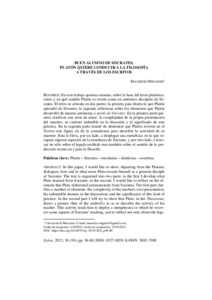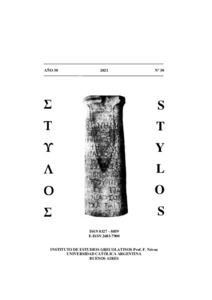Please use this identifier to cite or link to this item:
https://repositorio.uca.edu.ar/handle/123456789/13379| Título: | Buen alumno de Sócrates : Platón quiere conducir a la filosofía a través de los escritos | Autor: | Migliori, Maurizio | Palabras clave: | Platón, 427-347 a. C.; SOCRATES; ENSEÑANZA; DIALECTICA; ESCRITURA; LITERATURA GRIEGA; FILOSOFIA | Fecha de publicación: | 2021 | Editorial: | Pontificia Universidad Católica Argentina. Facultad de Filosofía y Letras. Instituto de estudios grecolatinos "Prof. F. Nóvoa" | Cita: | Migliori, M. Buen alumno de Sócrates : Platón quiere conducir a la filosofía a través de los escritos [en línea]. Stylos. 2021, 30. doi: 10.46553/sty.30.30.2021.p 56-80. Disponible en: https://repositorio.uca.edu.ar/handle/123456789/13379 | Resumen: | Resumen: En este trabajo quisiera mostrar, sobre la base del texto platónico, cómo y en qué sentido Platón se revela como un auténtico discípulo de Só-
crates. El texto se articula en dos partes: la primera para ilustra lo que Platón aprendió de Sócrates; la segunda reflexiona sobre los elementos que Platón desarrolló de manera autónoma a partir de Sócrates. En la primera parte qui-
siera clarificar una serie de datos: la complejidad de la propia presentación del maestro, su carácter imbatible en la discusión y el significado de esta práctica. En la segunda parte trataré de demostrar que Platón inventa en el Teeteto una figura (la de la comadrona) para describir la actividad de su maestro. Esta lo lleva, por un lado, a desplegar una metafísica en la que recupera algunos aspectos de la enseñanza de Sócrates, y por otro lado, a teorizar no sólo sobre el legado recibido sino también sobre el sentido de la producción escrita en y para la filosofía. Abstract: In this paper, I would like to show, departing from the Platonic dialogues, how and in what sense Plato reveals himself as a genuine disciple of Socrates. The text is organized into two parts: in the first I develop what Plato learned from Socrates; in the second, I would like to reflect on the el- ements that Plato elaborated autonomously from Socrates. The first part clar- ifies a number of elements: the complexity of the teacher's own presentation, his unbeatable domain in the discussions and the significance of this kind of practice. In the second part I will try to show that Plato, in the Theaetetus, draws a picture (that of the midwife) so as to describe the activity of his teacher. This activity leads him to deploy a metaphysics in which he recovers some aspects of Socrates' teaching, and to reflect not only about the legacy he inherited but also about the meaning of the written productions in and for philosophy. |
URI: | https://repositorio.uca.edu.ar/handle/123456789/13379 | ISSN: | 0327-8859 (impreso) 2683-7900 (online) |
Disciplina: | LITERATURA | DOI: | 10.46553/sty.30.30.2021.p 56-80 | Derechos: | Acceso abierto | Fuente: | Stylos. 2021, 30 |
| Appears in Collections: | STY - 2021 nro. 30 STY - 2021 nro. 30 |
Files in This Item:
| File | Description | Size | Format | |
|---|---|---|---|---|
| buen-alumno-Sócrates.pdf | 346,45 kB | Adobe PDF |  View/Open | |
| stylos30_portada.pdf | 128,89 kB | Adobe PDF |  View/Open |
Page view(s)
110
checked on Apr 27, 2024
Download(s)
420
checked on Apr 27, 2024
Google ScholarTM
Check
Altmetric
Altmetric
This item is licensed under a Creative Commons License

